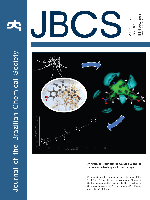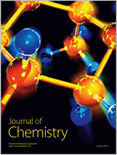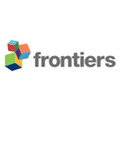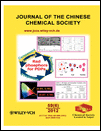
Oriental Journal of Chemistry
Scope & Guideline
Exploring the Frontiers of Chemical Knowledge.
Introduction
Aims and Scopes
- Synthesis and Characterization of Chemical Compounds:
The journal features extensive research on the synthesis of novel chemical compounds, including organic, inorganic, and nanomaterials, and their characterization using various techniques such as spectroscopy, chromatography, and microscopy. - Environmental Chemistry and Pollution Remediation:
Research focused on the analysis and remediation of environmental pollutants, including heavy metals and dyes, is a core area of interest, promoting sustainable practices and eco-friendly solutions. - Biological Applications of Chemical Compounds:
The journal publishes studies that explore the biological activities of synthesized compounds, including their antimicrobial, anticancer, and antioxidant properties, highlighting the therapeutic potential of chemical research. - Nanotechnology and Material Science:
A significant emphasis is placed on nanotechnology, covering the synthesis, characterization, and application of nanoparticles in various fields, including catalysis, drug delivery, and environmental remediation. - Analytical Chemistry and Method Development:
The journal includes research on the development and validation of analytical methods for the detection and quantification of various substances, contributing to advancements in chemical analysis.
Trending and Emerging
- Green Chemistry and Sustainable Practices:
There is a growing trend towards research in green chemistry, emphasizing environmentally friendly synthesis methods and sustainable practices, reflecting global efforts to reduce chemical waste and pollution. - Nanomaterials and Their Applications:
The focus on nanomaterials continues to rise, with an increasing number of studies exploring their synthesis, characterization, and applications in medicine, catalysis, and environmental remediation. - Pharmacological and Medicinal Chemistry:
Research on the pharmacological properties of chemical compounds, particularly those derived from natural products or synthesized for specific therapeutic targets, is gaining momentum, addressing the need for new drug development. - Analytical Methods for Environmental Monitoring:
There is an increasing emphasis on the development of advanced analytical techniques for environmental monitoring, particularly for detecting pollutants and assessing water quality, aligning with global environmental concerns. - Interdisciplinary Approaches:
The journal is seeing a rise in interdisciplinary research that combines chemistry with biology, environmental science, and engineering, promoting holistic approaches to solve complex scientific problems.
Declining or Waning
- Traditional Organic Synthesis:
There is a noticeable decline in papers focusing on traditional organic synthesis methods, as researchers increasingly favor greener and more efficient synthesis approaches, such as biocatalysis and microwave-assisted techniques. - Basic Physical Chemistry Studies:
Papers dedicated solely to fundamental studies in physical chemistry, such as thermodynamics and kinetics, are becoming less frequent, possibly due to a growing interest in applied and interdisciplinary research. - Inorganic Coordination Chemistry:
Research specifically focused on classical inorganic coordination complexes has waned, as there is a noticeable shift towards more complex and functional materials, including metal-organic frameworks (MOFs) and hybrid materials. - Theoretical Studies Without Experimental Validation:
There is a decrease in purely theoretical studies that do not include experimental validation, as the trend moves towards integrated approaches that combine theoretical predictions with experimental results.
Similar Journals

Chemical Methodologies
Advancing Chemistry Through Innovative MethodologiesWelcome to Chemical Methodologies, a premier journal published by SAMI PUBLISHING CO-SPC, dedicated to advancing the field of chemistry through innovative research and methodologies. With an ISSN of 2645-7776 and an E-ISSN of 2588-4344, this journal provides a vital platform for researchers and scholars to share their findings in areas encompassing physical, theoretical, and organic chemistry. Despite its initial HIndex and quartile rankings still being established, the journal's evolving impact within the academic landscape is underscored by its Scopus Ranks, which place it in the 35th percentile for physical and theoretical chemistry and the 33rd percentile for organic chemistry. Since its inception in 2022, and continuing through 2024, Chemical Methodologies aims to foster collaboration and knowledge dissemination among academics and practitioners alike, bridging theoretical concepts and practical applications. This open-access platform enhances accessibility for researchers and students worldwide, ensuring that groundbreaking contributions to chemical science reach a broad audience.

JOURNAL OF THE BRAZILIAN CHEMICAL SOCIETY
Pioneering Discoveries: Your Gateway to Global Chemical ResearchThe Journal of the Brazilian Chemical Society (ISSN: 0103-5053; E-ISSN: 1678-4790), published by the Sociedade Brasileira de Química, stands as a prominent outlet for disseminating high-quality research in the field of chemistry. Since its establishment as an Open Access journal in 1990, it has been committed to providing unrestricted access to innovative findings and discussions that propel the advancement of chemical sciences globally. Located in the vibrant research landscape of Brazil, this journal aims to showcase a wide range of topics including analytical, organic, inorganic, and physical chemistry, among others, catering to a diverse audience of researchers, professionals, and students alike. The journal holds a noteworthy distinction with a Q3 quartile ranking in the field of miscellaneous chemistry for 2023 and is indexed in Scopus, reflecting its growing influence in the academic community. With a publication cycle that spans continuously from 1990 through 2024, it serves as a vital resource for anyone seeking to stay informed about the latest trends and breakthroughs in chemistry.

Journal of Chemistry
Fostering Collaboration in Chemical ResearchJournal of Chemistry, published by Hindawi Ltd, serves as a critical platform for advancing knowledge in the field of chemistry, particularly in its miscellaneous sub-disciplines. With an impressive 2023 Scopus Rank of #123 out of 408 and positioned in the Q2 quartile, this journal exemplifies a robust academic rigor that appeals to researchers, professionals, and students alike. It features articles related to innovative chemical research and developments, catering to a diverse audience eager to contribute to the growing body of literature in the chemical sciences. The journal has been operational from 2013 to 2024, and its Open Access model ensures that findings are easily accessible to a global audience, fostering collaboration and knowledge sharing. With a commitment to quality and relevance, the Journal of Chemistry continues to play a significant role in shaping contemporary chemical research and education.

DOKLADY CHEMISTRY
Elevating the discourse in diverse chemistry realms.DOKLADY CHEMISTRY is an esteemed academic journal published by MAIK NAUKA/INTERPERIODICA/SPRINGER, focusing on the dynamic field of chemistry. Established in 1996, this journal serves as a significant platform for disseminating cutting-edge research, reviews, and significant developments in various areas of chemistry, including but not limited to general and miscellaneous chemistry. Currently indexed with an ISSN of 0012-5008 and E-ISSN of 1608-3113, DOKLADY CHEMISTRY maintains a commitment to academic rigor and integrity, contributing critical insights to the scientific community. Despite its Q4 ranking in the 2023 Chemistry category and a Scopus rank of #314 out of 408, this journal remains an important resource for researchers, professionals, and students eager to explore emerging trends and innovative methodologies in the field. The journal operates under a model that supports comprehensive scholarly communication, making it a key fixture among established chemistry publications.

Canadian Journal of Chemistry
Uniting Scholars for a Brighter Chemical FutureWelcome to the Canadian Journal of Chemistry, a prominent publication dedicated to advancing the study of chemistry through original research and critical reviews. Published by Canadian Science Publishing, this journal has been a cornerstone of chemical research since its inception, covering a broad spectrum of topics within the field, including catalysis, organic chemistry, and general chemistry. With an ISSN of 0008-4042 and E-ISSN of 1480-3291, it provides a vital platform for researchers, professionals, and students to disseminate their findings and engage in scholarly discourse. Impact Factor is currently in development, with the journal classified in the Q4 category for catalysis and Q3 for miscellaneous chemistry fields, signifying its evolving contributions to the scientific community. The journal operates without an open access model, which ensures a rigorous peer-review process while maintaining subscription access for institutions and libraries. Located in Ottawa, Canada, the Canadian Journal of Chemistry continues to provide an invaluable resource for those dedicated to the scientific pursuit of chemistry, making significant strides in fostering interdisciplinary approaches and innovative research methodologies.

CHINESE JOURNAL OF CHEMISTRY
Connecting global minds in chemistry.The CHINESE JOURNAL OF CHEMISTRY, published by WILEY-V C H VERLAG GMBH, is a distinguished peer-reviewed journal that has been contributing to the field of chemistry since its inception in 1990. With an impressive Q1 ranking in the Chemistry (miscellaneous) category and a Scopus rank of 67 out of 408, this journal is recognized for its rigorous scholarly standards and significant impact within the academic community. Renowned for publishing high-quality research, reviews, and insightful commentaries, the journal serves as a vital resource for researchers, professionals, and students keen on advancing their understanding of general chemistry and its applications. Although it does not offer open access, the journal remains an essential outlet for innovative chemistry research, attracting contributions from a global network of specialists. With its broad scope covering various aspects of chemistry and a commitment to fostering scientific dialogue, the CHINESE JOURNAL OF CHEMISTRY is poised to continue its role as a central pillar in the ever-evolving landscape of chemical sciences.

Revista Virtual de Quimica
Bridging Disciplines with Cutting-edge Chemistry InsightsRevista Virtual de Quimica, published by the SOC BRASILEIRA QUIMICA, is a dynamic online journal based in Brazil, dedicated to promoting innovative research in the field of chemistry and related disciplines. Established in 2011, the journal has made significant strides in contributing to the academic landscape, receiving an impact factor that highlights its relevance, although it currently holds a Q4 quartile ranking in the miscellaneous category of Chemistry and Mathematics as of 2023. The journal is committed to open access, ensuring that scholarly articles are readily available to researchers, professionals, and students worldwide. Its focus encompasses diverse areas within general chemistry, aiming to foster knowledge sharing and collaboration among the scientific community. By providing a platform for high-quality research publications, Revista Virtual de Quimica stands as an essential resource for advancing chemical sciences and encouraging interdisciplinary studies.

Frontiers in Chemistry
Empowering Global Collaboration in Chemical Research.Frontiers in Chemistry is an esteemed and innovative Open Access journal published by FRONTIERS MEDIA SA, based in Lausanne, Switzerland. Since its inception in 2013, the journal has established itself as a leading platform for the dissemination of high-quality research across a broad spectrum of chemistry disciplines, achieving a notable Q1 classification in the miscellaneous chemistry category as of 2023. With an impressive Scopus rank, placing it at 72nd out of 408 in General Chemistry and falling within the 82nd percentile, Frontiers in Chemistry is committed to publishing significant findings that contribute to the advancement of the field. The journal's Open Access model ensures that research is freely accessible to all, fostering a greater exchange of knowledge and collaboration among researchers, professionals, and students globally. It covers a range of topics, from organic and inorganic chemistry to materials science and biochemistry, making it an essential resource for anyone seeking to stay at the forefront of chemical research.

JOURNAL OF THE CHINESE CHEMICAL SOCIETY
Advancing Chemistry Through Innovative ResearchJOURNAL OF THE CHINESE CHEMICAL SOCIETY, published by WILEY-V C H VERLAG GMBH, is a vital resource in the field of chemistry, focusing on a broad array of topics pertinent to general chemistry and its advancing sub-disciplines. Established in 1954 and running through 2024, this journal serves as a significant platform for the dissemination of high-quality research, showcasing innovative findings and developments within the chemical sciences. With its Q3 category ranking and positioning at Rank #203 in General Chemistry per Scopus, it reflects the journal's commitment to research excellence and impact. While not an open-access publication, it ensures accessibility to a global audience, making it an essential tool for researchers, professionals, and students alike seeking to stay informed and engaged in the evolving landscape of chemistry.

JOURNAL OF THE CHILEAN CHEMICAL SOCIETY
Advancing Chemistry through Collaborative Research.The Journal of the Chilean Chemical Society, published by the Sociedad Chilena de Química, serves as a premier platform for disseminating significant research findings in the field of Chemistry. With an ISSN of 0717-9707, this journal has established its presence since 2003, providing open access to a diverse range of studies and advancements in this vital scientific domain. It currently holds a Q3 category ranking in Chemistry (miscellaneous) and ranks 196 out of 408 in the general chemistry category on Scopus, indicating its valuable contributions to the field. Through the journal, researchers, professionals, and students are encouraged to engage with cutting-edge research and foster collaboration among the scientific community in Chile and beyond. The society's commitment to excellence ensures that articles published reflect high-quality research, underpinning the journal’s role in shaping knowledge and innovation in chemistry.